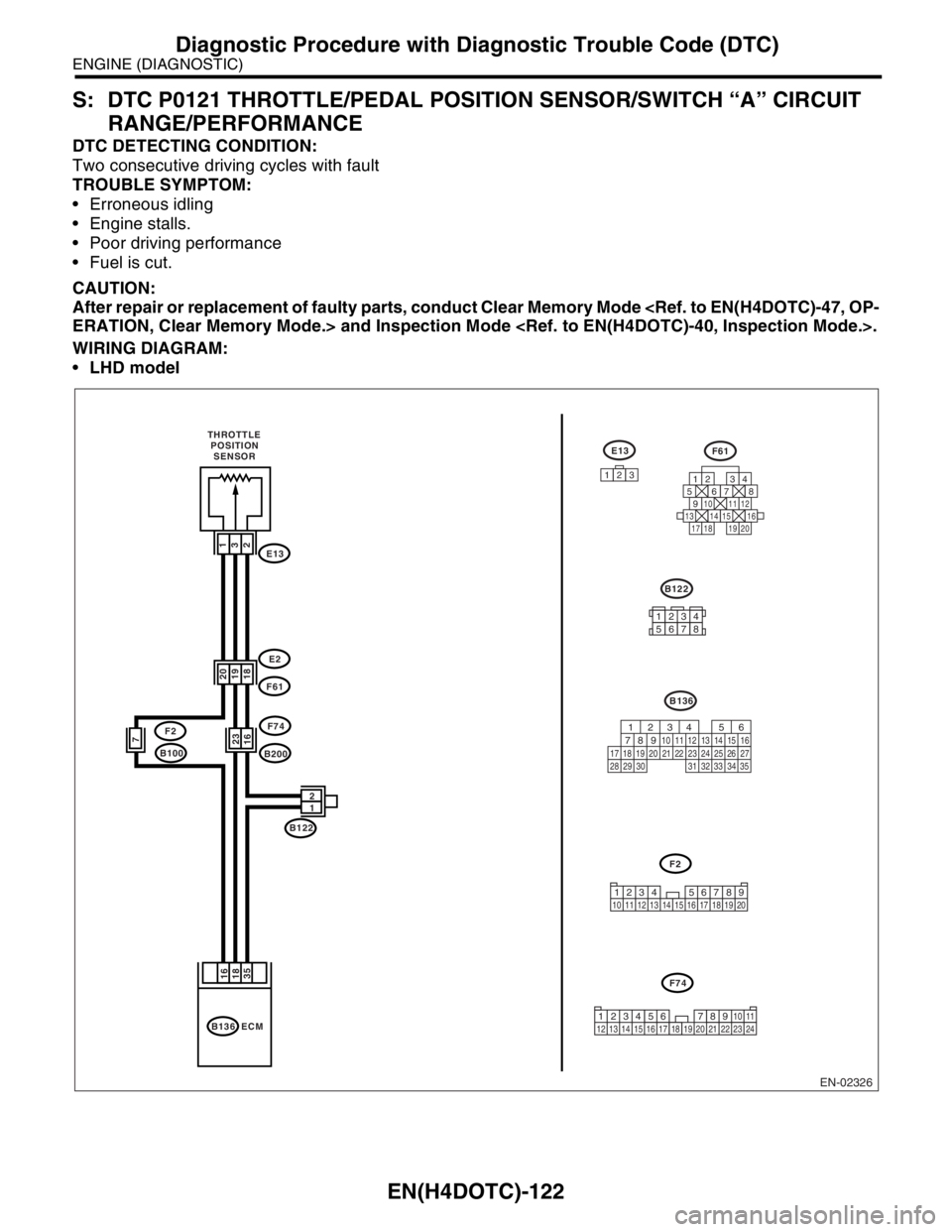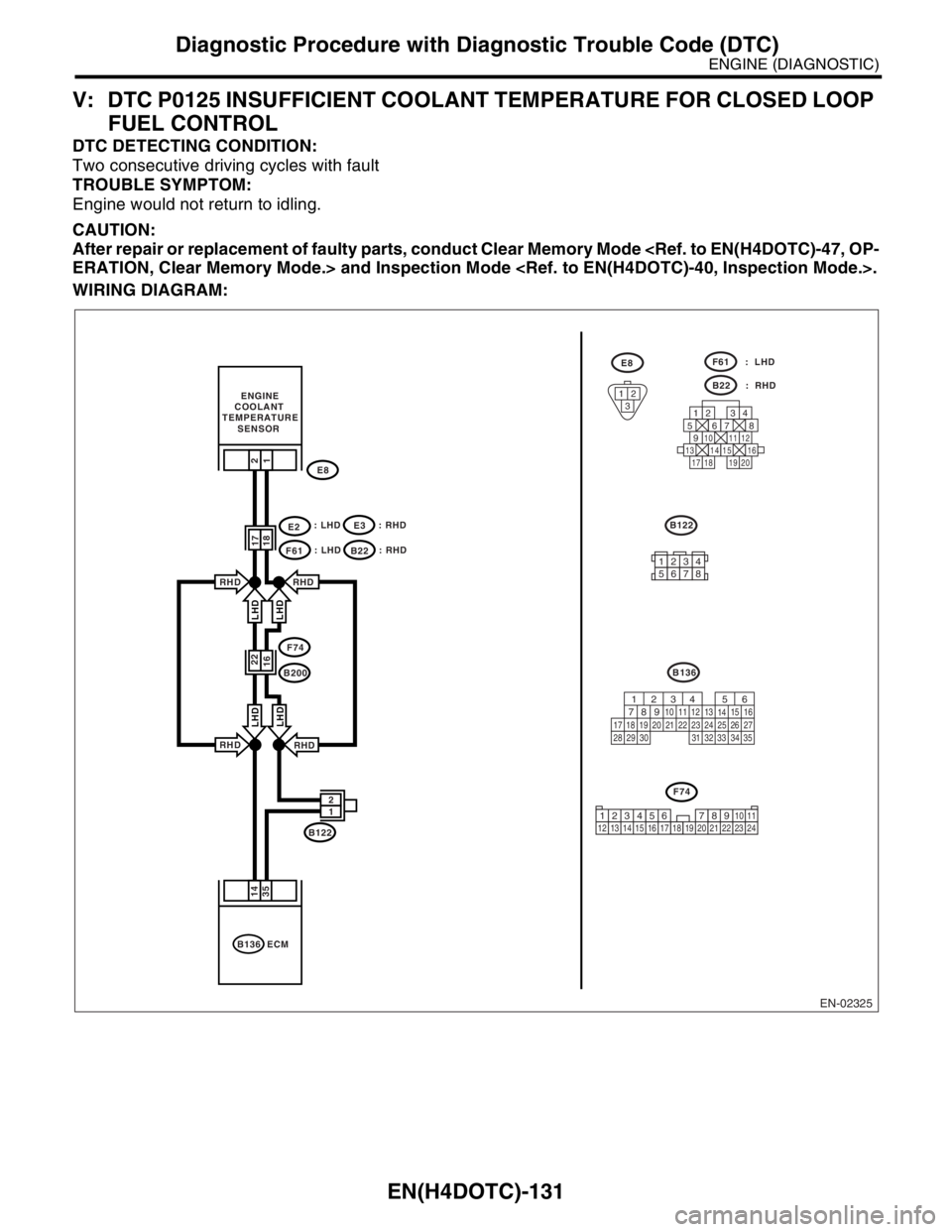2004 SUBARU FORESTER fuel
[x] Cancel search: fuelPage 1703 of 2870

EN(H4DOTC)-73
ENGINE (DIAGNOSTIC)
Diagnostics for Engine Starting Failure
Step Check Yes No
1 CHECK OPERATION OF EACH FUEL INJEC-
TOR.
While cranking the engine, check that each
fuel injector emits operating sound.Use a
sound scope or attach a screwdriver to the
injector for this check.Does the fuel pump produce
operating sound?Check the fuel
pressure.
INSPECTION,
Fuel Pressure.>Go to step 2.
2 CHECK POWER SUPPLY TO EACH FUEL
INJECTOR.
1) Turn the ignition switch to OFF.
2) Disconnect the connector from fuel injector.
3) Turn the ignition switch to ON.
4) Measure the power supply voltage between
fuel injector terminal and engine ground.
Connector & terminal
#1 (E5) No. 2 (+) — Engine ground (
−):
#2 (E16) No. 2 (+) — Engine ground (
−):
#3 (E6) No. 2 (+) — Engine ground (
−):
#4 (E17) No. 2 (+) — Engine ground (
−):Is the voltage more than 10 V? Go to step 3.Repair the har-
ness and connec-
tor.
N
OTE:
In this case repair
the following:
Open circuit in
harness between
main relay and fuel
injector connector
Poor contact in
main relay connec-
tor
Poor contact in
coupling connector
Poor contact in
fuel injector con-
nector
3 CHECK HARNESS BETWEEN ECM AND
FUEL INJECTOR CONNECTOR.
1) Disconnect the connector from ECM.
2) Measure the resistance of harness
between ECM and fuel injector connector.
Connector & terminal
(B136) No. 6 — (E5) No. 1:
(B136) No. 5 — (E16) No. 1:
(B136) No. 4 — (E6) No. 1:
(B136) No. 3 — (E6) No. 1:Is the resistance less than 1
Ω?Go to step 4.Repair the har-
ness and connec-
tor.
NOTE:
In this case repair
the following:
Open circuit in
harness between
ECM and fuel
injector connector
Poor contact in
coupling connector
4 CHECK HARNESS BETWEEN ECM AND
FUEL INJECTOR CONNECTOR.
Measure the resistance of harness between
ECM and fuel injector connector.
Connector & terminal
(B136) No. 6 — Chassis ground:
(B136) No. 5 — Chassis ground:
(B136) No. 4 — Chassis ground:
(B136) No. 3 — Chassis ground:Is the resistance less than 1
Ω?Repair ground
short circuit in har-
ness between
ECM and fuel
injector connector.Go to step 5.
5 CHECK EACH FUEL INJECTOR.
1) Turn the ignition switch to OFF.
2) Measure the resistance between each fuel
injector terminals.
Te r m i n a l s
No. 1 — No. 2:Is the resistance 5 — 20 Ω? Go to step 6.Replace the faulty
fuel injector.
6 CHECK POOR CONTACT.
Check poor contact in ECM connector.Is there poor contact in ECM
connector?Repair the poor
contact in ECM
connector.Inspection using
“General Diagnos-
tic Table”
295, INSPEC-
TION, General
Diagnostic Table.>
Page 1705 of 2870

EN(H4DOTC)-75
ENGINE (DIAGNOSTIC)
List of Diagnostic Trouble Code (DTC)
P0121 Throttle/Pedal Position Sensor/
Switch “A” Circuit Range/Perfor-
mance
cedure with Diagnostic Trouble Code (DTC).>
P0122 Throttle/Pedal Position Sensor/
Switch “A” Circuit Low Input
Diagnostic Trouble Code (DTC).>
P0123 Throttle/Pedal Position Sensor/
Switch “A” Circuit High Input
Diagnostic Trouble Code (DTC).>
P0125 Insufficient Coolant Temperature
For Closed Loop Fuel Control
with Diagnostic Trouble Code (DTC).>
P0129 Barometric Pressure Too Low
P0131 O
2 Sensor Circuit Low Voltage
(Bank 1 Sensor 1)
Code (DTC).>
P0132 O
2 Sensor Circuit High Voltage
(Bank 1 Sensor 1)
Trouble Code (DTC).>
P0133 O
2 Sensor Circuit Slow Response
(Bank 1 Sensor 1)
Trouble Code (DTC).>
P0134 O
2 Sensor Circuit No Activity
Detected (Bank 1 Sensor 1)
tic Trouble Code (DTC).>
P0137 O
2 Sensor Circuit Low Voltage
(Bank 1 Sensor 2)
Code (DTC).>
P0138 O
2 Sensor Circuit High Voltage
(Bank 1 Sensor 2)
Trouble Code (DTC).>
P0139 O
2 Sensor Circuit Slow Response
(Bank 1 Sensor 2)
Trouble Code (DTC).>
P0171 System Too Lean (Bank 1)
P0172 System Too Rich (Bank 1)
P0230 Fuel Pump Primary Circuit
P0244 Turbo/Super Charger Wastegate
Solenoid “A” Range/Performance
dure with Diagnostic Trouble Code (DTC).>
P0245 Turbo/Super Charger Wastegate
Solenoid “A” Low
Trouble Code (DTC).>
P0246 Turbo/Super Charger Wastegate
Solenoid “A” High
Trouble Code (DTC).>
P0301 Cylinder 1 Misfire Detected
P0302 Cylinder 2 Misfire Detected
P0303 Cylinder 3 Misfire Detected
Page 1706 of 2870

EN(H4DOTC)-76
ENGINE (DIAGNOSTIC)
List of Diagnostic Trouble Code (DTC)
P0304 Cylinder 4 Misfire Detected
P0327 Knock Sensor 1 Circuit Low Input
(Bank 1 or Single Sensor)
nostic Trouble Code (DTC).>
P0328 Knock Sensor 1 Circuit High Input
(Bank 1 or Single Sensor)
nostic Trouble Code (DTC).>
P0335 Crankshaft Position Sensor “A” Cir-
cuit
(DTC).>
P0336 Crankshaft Position Sensor “A” Cir-
cuit Range/Performance
Diagnostic Trouble Code (DTC).>
P0340 Camshaft Position Sensor “A” Cir-
cuit (Bank 1 or Single Sensor)
Diagnostic Trouble Code (DTC).>
P0341 Camshaft Position Sensor “A” Cir-
cuit Range/Performance (Bank 1 or
Single Sensor)
Diagnostic Procedure with Diagnostic Trouble Code (DTC).>
P0365 Camshaft Position Sensor “B” Cir-
cuit (Bank 1)
(DTC).>
P0390 Camshaft Position Sensor “B” Cir-
cuit (Bank 2)
(DTC).>
P0420 Catalyst System Efficiency Below
Threshold (Bank 1)
Trouble Code (DTC).>
P0458 Evaporative Emission Control Sys-
tem Purge Control Valve Circuit
Low
cedure with Diagnostic Trouble Code (DTC).>
P0459 Evaporative Emission Control Sys-
tem Purge Control Valve Circuit
High
Procedure with Diagnostic Trouble Code (DTC).>
P0461 Fuel Level Sensor Circuit Range/
Performance
Code (DTC).>
P0462 Fuel Level Sensor Circuit Low
Input
P0463 Fuel Level Sensor Circuit High
Input
P0464 Fuel Level Sensor Circuit Intermit-
tent
(DTC).>
P0483 Cooling Fan Rationality Check
P0502 Vehicle Speed Sensor Circuit Low
Input
(DTC).>
P0503 Vehicle Speed Sensor Intermittent/
Erratic/High
(DTC).>
P0506 Idle Control System RPM Lower
Than Expected
Code (DTC).> DTC Item NOTE
Page 1710 of 2870

FUJI HEAVY INDUSTRIES LTD. G8080GE3
2004 FORESTER SERVICE MANUAL QUICK REFERENCE INDEX
ENGINE SECTION 2
This service manual has been prepared
to provide SUBARU service personnel
with the necessary information and data
for the correct maintenance and repair
of SUBARU vehicles.
This manual includes the procedures
for maintenance, disassembling, reas-
sembling, inspection and adjustment of
components and diagnostics for guid-
ance of experienced mechanics.
Please peruse and utilize this manual
fully to ensure complete repair work for
satisfying our customers by keeping
their vehicle in optimum condition.
When replacement of parts during
repair work is needed, be sure to use
SUBARU genuine parts.
All information, illustration and specifi-
cations contained in this manual are
based on the latest product information
available at the time of publication
approval.FUEL INJECTION (FUEL SYSTEM) FU(H4DOTC)
EMISSION CONTROL
(AUX. EMISSION CONTROL DEVICE)EC(H4DOTC)
INTAKE (INDUCTION) IN(H4DOTC)
MECHANICAL ME(H4DOTC)
EXHAUST EX(H4DOTC)
COOLING CO(H4DOTC)
LUBRICATION LU(H4DOTC)
SPEED CONTROL SYSTEM SP(H4DOTC)
IGNITION IG(H4DOTC)
STARTING/CHARGING SYSTEM SC(H4DOTC)
ENGINE (DIAGNOSTIC) EN(H4DOTC)
Page 1755 of 2870

EN(H4DOTC)-122
ENGINE (DIAGNOSTIC)
Diagnostic Procedure with Diagnostic Trouble Code (DTC)
S: DTC P0121 THROTTLE/PEDAL POSITION SENSOR/SWITCH “A” CIRCUIT
RANGE/PERFORMANCE
DTC DETECTING CONDITION:
Two consecutive driving cycles with fault
TROUBLE SYMPTOM:
Erroneous idling
Engine stalls.
Poor driving performance
Fuel is cut.
CAUTION:
After repair or replacement of faulty parts, conduct Clear Memory Mode
WIRING DIAGRAM:
LHD model
EN-02326
E2
E13
F61
F74
B200
B122 THROTTLE
POSITION
SENSOR
1
32
20
1918
1 2
B136 ECM
16
35 18
B136
E13
123
F61
125678
131415169101112
34
17181920
B122
F2
F2
B100
F74
12345678
56
782 1
94 310
24 22 23 2511 12 13
1415
26 27
2816
17 18 19 20 21
33 34 29
32 30
31 35
34
12 8910 11
12 13 14 15 16 17 18 19 20 21 22 23 2456 7
1234 5678910 11 12 13 14 15 16 17 18 19 20
723
16
Page 1764 of 2870

EN(H4DOTC)-131
ENGINE (DIAGNOSTIC)
Diagnostic Procedure with Diagnostic Trouble Code (DTC)
V: DTC P0125 INSUFFICIENT COOLANT TEMPERATURE FOR CLOSED LOOP
FUEL CONTROL
DTC DETECTING CONDITION:
Two consecutive driving cycles with fault
TROUBLE SYMPTOM:
Engine would not return to idling.
CAUTION:
After repair or replacement of faulty parts, conduct Clear Memory Mode
WIRING DIAGRAM:
EN-02325
B122
B136 ECM
35 14
E8 ENGINE
COOLANT
TEMPERATURE
SENSOR2
1
1 2
17
18
22
16F74
B200
LHD
LHD
RHD
RHD
LHD LHD
RHD
RHD
E8
12
3
B136
125678
131415169101112
34
17181920
B122B22 : RHD
F61 : LHD
F61
E2
: LHD
B22: RHD
F74
34
12 8910 11
12 13 14 15 16 17 18 19 20 21 22 23 2456 7
56
782 1
94 310
24 22 23 2511 12 13
1415
26 27
2816
17 18 19 20 21
33 34 29
32 30
31 35
12345678
: LHDE3: RHD
Page 1782 of 2870

EN(H4DOTC)-149
ENGINE (DIAGNOSTIC)
Diagnostic Procedure with Diagnostic Trouble Code (DTC)
AF:DTC P0172 SYSTEM TOO RICH (BANK 1)
DTC DETECTING CONDITION:
Two consecutive driving cycles with fault
TROUBLE SYMPTOM:
Erroneous idling
Engine stalls.
Poor driving performance
CAUTION:
After repair or replacement of faulty parts, conduct Clear Memory Mode
Step Check Yes No
1 CHECK EXHAUST SYSTEM.Are there holes or looseness of
the bolts on exhaust system?Repair exhaust
system.Go to step 2.
2 CHECK AIR INTAKE SYSTEM.Are there holes, loose bolts or
disconnection of hose on air
intake system?Repair air intake
system.Go to step 3.
3 CHECK FUEL PRESSURE.
Warning:
Place “NO FIRE” signs near the working
area.
Be careful not to spill fuel.
1) Release the fuel pressure.
(1) Disconnect the connector from fuel
pump relay.
(2) Start the engine and run it until it stalls.
(3) After the engine stalls, crank it for five
more seconds.
(4) Turn the ignition switch to OFF.
2) Connect the connector to fuel pump relay.
3) Disconnect the fuel delivery hose from fuel
filter, and connect the fuel pressure gauge.
4) Install the fuel filler cap.
5) Start the engine and idle while gear posi-
tion is neutral.
6) Measure the fuel pressure while discon-
necting pressure regulator vacuum hose from
intake manifold.
Warning:
Release fuel pressure before removing the
fuel pressure gauge.
N
OTE:
If fuel pressure does not increase, squeeze the
fuel return hose 2 to 3 times, then measure fuel
pressure again.Is measured value 284 — 314
kPa (2.9 — 3.2 kg/cm
2, 41 —
46 psi)?Go to step 4.Repair the follow-
ing items.
Fuel pressure is
too high:
Clogged fuel
return line or
bent hose
Fuel pressure is
too low:
Improper fuel
pump discharge
Clogged fuel
supply line
Page 1783 of 2870

EN(H4DOTC)-150
ENGINE (DIAGNOSTIC)
Diagnostic Procedure with Diagnostic Trouble Code (DTC)
4 CHECK FUEL PRESSURE.
After connecting the pressure regulator vac-
uum hose, measure fuel pressure.
Warning:
Release fuel pressure before removing the
fuel pressure gauge.
N
OTE:
If fuel pressure does not increase, squeeze
fuel return hose 2 to 3 times, then measure
fuel pressure again.
If out of specification as measured at this
step, check or replace pressure regulator and
pressure regulator vacuum hose.Is measured value 206 — 235
kPa (2.1 — 2.4 kg/cm
2, 30 —
34 psi)?Go to step 5.Repair the follow-
ing items.
Fuel pressure is
too high:
Faulty pres-
sure regulator
Clogged fuel
return line or
bent hose
Fuel pressure is
too low:
Faulty pres-
sure regulator
Improper fuel
pump discharge
Clogged fuel
supply line
5 CHECK ENGINE COOLANT TEMPERATURE
SENSOR.
1) Start the engine and warm-up completely.
2) Read the data of engine coolant tempera-
ture sensor signal using Subaru Select Monitor
or the OBD-II general scan tool.
NOTE:
Subaru Select Monitor
For detailed operation procedure, refer to
“READ CURRENT DATA SHOWN ON DIS-
PLAY FOR ENGINE”.
OBD-II general scan tool
For detailed operation procedures, refer to the
OBD-II General Scan Tool Operation Manual.Is engine coolant temperature
more than 60°C (140°F)?Go to step 6.Replace the
engine coolant
temperature sen-
sor.
Engine Coolant
Temperature Sen-
sor.>
6 CHECK MASS AIR FLOW AND INTAKE AIR
TEMPERATURE SENSOR.
1) Start and warm-up the engine until engine
coolant temperature is greater than 60°C
(140°F).
2) Place the shift lever in neutral position.
3) Turn the A/C switch to OFF.
4) Turn all accessory switches to OFF.
5) Read the data of mass air flow and intake
air temperature sensor signal using Subaru
Select Monitor or the OBD-II general scan tool.
N
OTE:
Subaru Select Monitor
For detailed operation procedure, refer to
“READ CURRENT DATA SHOWN ON DIS-
PLAY FOR ENGINE”.
OBD-II general scan tool
For detailed operation procedures, refer to the
OBD-II General Scan Tool Operation Manual.Is the measured value within
the following?
Ignition ON: 73.3 — 106.6 kPa
(550 — 800 mmHg, 21.65 —
31.50 inHg)
Idling: 24.0 — 41.3 kPa (180 —
310 mmHg, 7.09 — 12.20
inHg)Go to step 7.Replace the mass
air flow and intake
air temperature
sensor.
Mass Air Flow and
Intake Air Temper-
ature Sensor.> Step Check Yes No